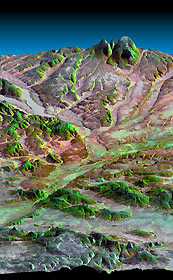
Save this image free of charge
in 800 pixels for layout use
(right click, Save as...)
|
|
Ref : V02083
Theme :
Looking at Earth - Sea - Coast - Capes - Peninsula (601 images)
Title : Kamchatka Peninsula, Russia 3-D Perspective with Landsat Overlay
Caption :
This three-dimensional perspective view, looking up the Tigil River, shows the western side of the volcanically active Kamchatka Peninsula, Russia. The image shows that the Tigil River has eroded down from a higher and differing landscape and now flows through, rather than around the large green-colored bedrock ridge in the foreground. The older surface was likely composed of volcanic ash and debris from eruptions of nearby volcanoes. The green tones indicate that denser vegetation grows on south facing sunlit slopes at the northern latitudes. High resolution SRTM elevation data will be used by geologists to study how rivers shape the landscape, and by ecologists to study the influence of topography on ecosystems.This image shows how data collected by the Shuttle Radar Topography Mission (SRTM) can be used to enhance other satellite images. Color and natural shading are provided by a Landsat 7 image acquired on January 31, 2000. Terrain perspective and shading were derived from SRTM elevation data acquired on February 12, 2000. Topography is exaggerated by about six times vertically. The Shuttle Radar Topography Mission (SRTM), launched on February 11, 2000, uses the same radar instrument that comprised the Spaceborne Imaging Radar-C/X-Band Synthetic Aperture Radar (SIR-C/X-SAR) that flew twice on the Space Shuttle Endeavour in 1994. The mission is designed to collect three-dimensional measurements of the Earth's surface. To collect the 3-D data, engineers added a 60-meter-long (200-foot) mast, an additional C-band imaging antenna and improved tracking and navigation devices. The mission is a cooperative project between the National Aeronautics and Space Administration (NASA), the National Imagery and Mapping Agency (NIMA) and the German (DLR) and Italian (ASI) space agencies. It is managed by NASA's Jet Propulsion Laboratory, Pasadena, CA, for NASA's Earth Science Enterprise, Washington, DC.Size: 71 km (44 miles) x 20 km (12 miles) Location: 57 deg. North lat., 159 deg. East lon.Orientation: Looking to the east Original Data Resolution: 30 meters (99 feet) Date Acquired: February 12, 2000
|
|

